A Look at the Legacy of Nake'u Awai, the Godfather of Hawaiian Fashion

"Hearst Magazines and Yahoo may earn commission or revenue on some items through these links."
At 85, Native Hawaiian fashion designer Nake‘u Awai still insists on the reason he got into the business: “My intention was to design clothes for local people.”
For 50 years, Awai has remained steadfast in his raison d’être, designing garment after garment in his studio-cum-retail shop in Kapālama, an Oahu neighborhood steeped in the islands’ culture and history (iconic eatery Helena’s Hawaiian Food and the Bishop Museum are blocks away), for generations of local families to wear, while quietly creating the urtext for Hawaiian fashion.
Awai would never own up to such a legacy, though.
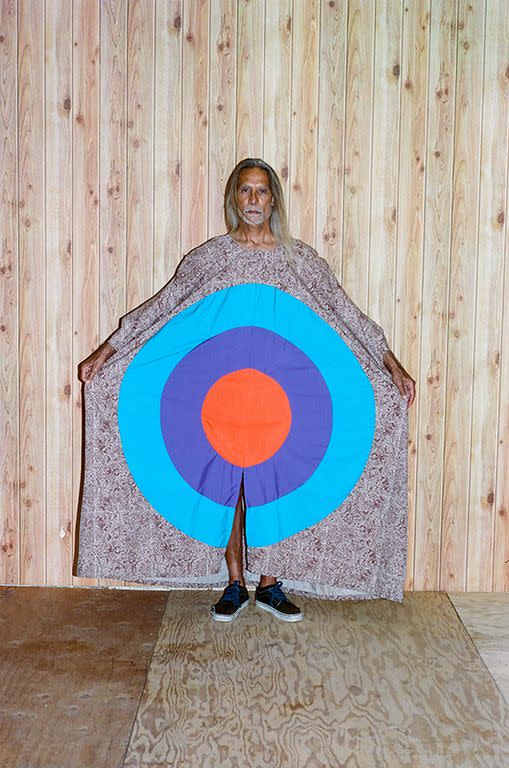
Awai—whom everyone affectionately calls “Uncle”—arrives at this store on a postcard-clear day in October, draped in his usual uniform: an aloha shirt of his own design (electric-red hala print on white fabric), matching red neckerchief, corduroy slacks, and comfortable close-toed shoes. Speaking from a comfortable perch, his fingers weighted with polished silver and opaque jade rings (a nod to the Chinese part of his heritage), he is unassuming about his impact on the local industry.
Unusual, for a trained showman—Awai’s first career was as a dancer and singer in New York and Los Angeles, after he graduated in 1960 with a dramatic arts degree from the University of Washington. He does become easily animate talking about his early days performing in Rodgers and Hammerstein’s Flower Drum Song or alongside Hawaiian entertainer Jimmy Borges, or his first side gigs making macramé belts and collars with a friend for Beverly Hills department stores and costumiers Bob Mackie and Jean Louis Berthault (who styled the pieces on Elvis Presley and Goldie Hawn, respectively), or shammy scarf skirts and wrap tops for Sammy Davis Jr.’s dancers.
Even if Awai is not as forthcoming about his own design career, proof of his legacy exists.
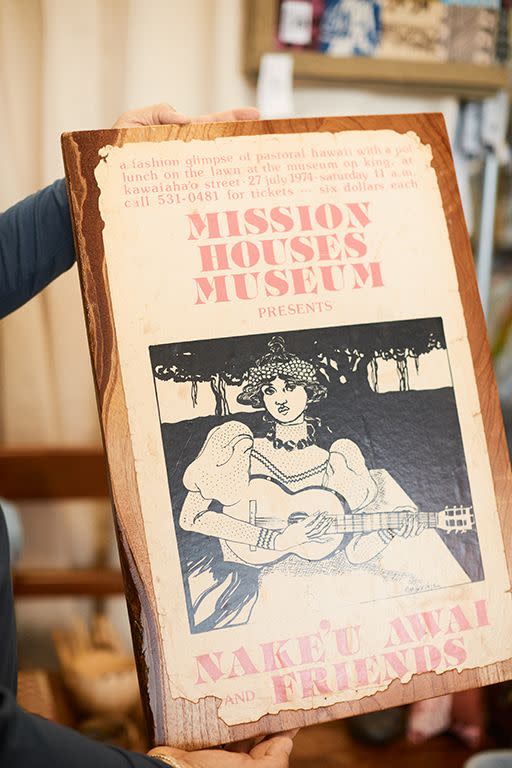
Today, Hawaiian fashion is inextricable from designs and prints with ties to the state’s Indigenous culture or history. But in the early 1970s, when Awai moved back to Hawaii and started his business with a loan from his father, local fashion was yoked to outsiders’ perceptions. All of the available fabrics were imported from Japan, England, or the U.S. mainland, without any motifs reflective of the islands. Importing fabric was a long-standing tradition, after the first white missionaries had brought their own with them, and Hawaiians adopted the Western style of dress, more or less abandoning kapa, a textile created by beating the fibers of mulberry and other plants. Awai called his first label Khaki Wahine, with backwards ks and one upside-down a.
“Hawaiian was a flower,” says designer Danene Lunn, president of ready-to-wear label Manuheali‘i. Her mother was a fabric dealer. As a child, Lunn would flip through her mother’s swatch books and see a print labeled “Hawaiian” in quotation marks. Inevitably, she says, “it was a flower with five petals or an occasional orchid.” Even the islands’ best-known fashion export, the brightly colored button-up aloha shirt, used imported fabrics in the service of providing souvenirs for tourists, rather than representing authentic island life.

Alohawear retailers Watumull’s and Alfred Shaheen created prints with Hawaiian flora and fauna first, but Awai and his contemporary, painter and fashion designer Allen Akina (who died of AIDS at 51 in 1991), were the first independent Kānaka Maoli (Native Hawaiian) designers to incorporate Indigenous motifs like hula dancers and lauhala fans, says E. Tory Laitila, curator of textiles and historic arts of Hawai‘i at the Honolulu Museum of Art. Though it might have been an ingenious move, Awai—who commissions artists for his prints—claims he did it out of desperation: Larger department stores bought out the fabrics he wanted.
Alongside Akina, Awai sold his designs at craft fairs. At Hawaiian Mission Houses, a historic site and archive, the two produced strolling mini fashion shows—which were boundary-breaking at the time. “All of the models were Hawaiian, Chinese, Filipino, Japanese,” remembers Lunn, who attended to help her mother sell patchwork muumuus. In an era before “Representation matters,” Awai and Akina proved that spotlighting the local population and culture does matter, unwittingly bringing up a generation of designers behind them.
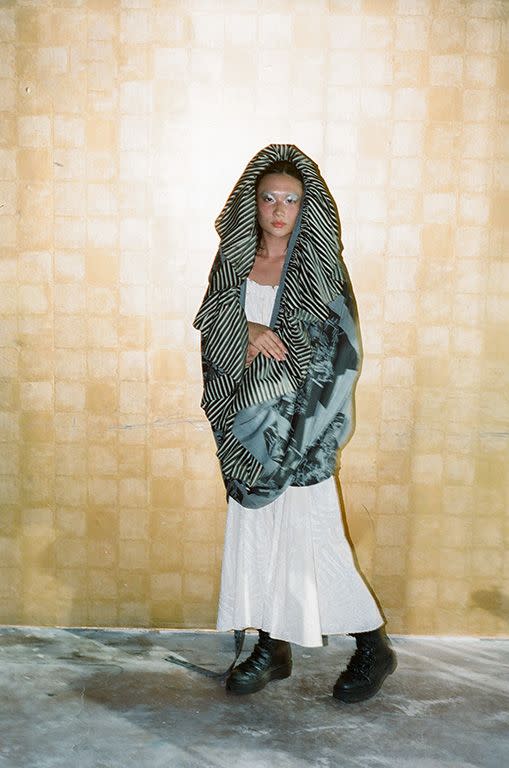
“He has a natural flair that really elevated Hawaiian fashion from a Native Hawaiian’s perspective,” says Hilo-based designer Sig Zane, who credits Awai with giving him the confidence to pursue his own label, after the older designer bought Zane’s artwork—maidenhair fern, gardenia flower, and kukui leaves and fruit—for his eponymous label. “He is the epitome of a Hawaiian fashion icon.”
There’s the fact that the clothing is arresting. The prints, often finely detailed, are enlarged or placed in repeating rows. The colors are vibrant or colorblocked. The designs are singular. Even when riffing on historic silhouettes—the holokū, a loose, seamed dress with leg-of-mutton sleeves, an above-the-bust yoke, and a train introduced by Western missionaries; the muumuu, a short-sleeved chemise to wear under the holokū; and the beloved aloha shirt, a multicultural mashup of shirting styles—an Awai garment is distinctive because of its inimitable mix of color, fabric, and pattern placement, not to mention its flattering feminine fit.
“It’s the way he puts things together,” says Kanoe Cazimero, a hula dancer and early model in his shows. “He has a sense of female grace.”
Ever the dancer, Awai is attuned to the body and its movements, a woman’s curves and her insecurities. For his Kīkepa style—a strapless dress with drawstring ties that gathers as it cinches—he raised the front slightly, creating a subtle train, for ease of walking. (“The Punahou length,” he calls it, referring to the elite private school in Honolulu, “because they liked to show their shoes.”) For the Godiva Mu’u, a bestseller with an off-the-shoulder neckline, he elongated and billowed the sleeves to conceal the winging underarm many dislike, and added a voluminous but relaxed ruffle hem. Both styles are versatile, with various ways to wear the neckline or add a belt for accentuation.
“He really understands the female form,” agrees Hie jewelry designer and Lei Aloha author Meleana Estes, who inherited many of her tūtū’s (grandmother’s) Nake‘u Awai pieces. “I love his details, like adding a ruffle and integrating a little lace here and there,” she says, citing his popular one-shoulder dress, which features whimsical double ruffles at the neckline and hem, and his Ka‘iulani mu‘u, which incorporates airy lace Swiss dot at the neckline and sleeves.
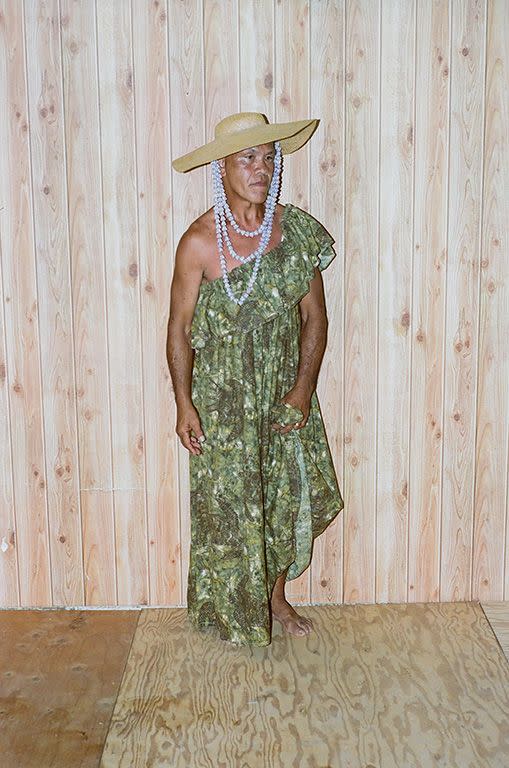
“He thinks about the whole garment,” says curator Laitila, referring to Awai’s strategic placements and understanding of movement, adding that Awai is among the most comprehensive designers, having done menswear, womenswear, clothing for keiki (children), accessories, and even homewares during his career. Designer Puamana Crabb, who started her line a decade after Awai’s, loves his frivolous, humorous, and meticulous sensibilities.
“When I wear [a Nake ‘u] in New York or Los Angeles, people freak out,” says Donnie Cervantes, co-director at artist-run gallery Aupuni Space. In July 2021, the Honolulu galleryheld a retrospective of Awai’s oeuvre and genderqueered the styling for a millennial and Gen Z audience that is often unfamiliar with his label. Despite long-standing cultural contributions, Awai remains an #IYKYK designer, discovered primarily through generational hand-me-downs or by pilfering Mom’s or Tūtū’s closet.
“I want to say that 80 percent of the local customers I come across don’t know Nake‘u,” says Lei Batty, owner of Honolulu vintage alohawear shop Destash, which houses over 600 pieces. Shoppers ask for Bete Mu‘u, Princess Kaiulani, and Manuheali‘i—all local labels known for their distinct spin on the muumuu, holokū, and Hawaiian prints—but rarely Awai. “I think it’s because he didn’t really market himself,” she says.
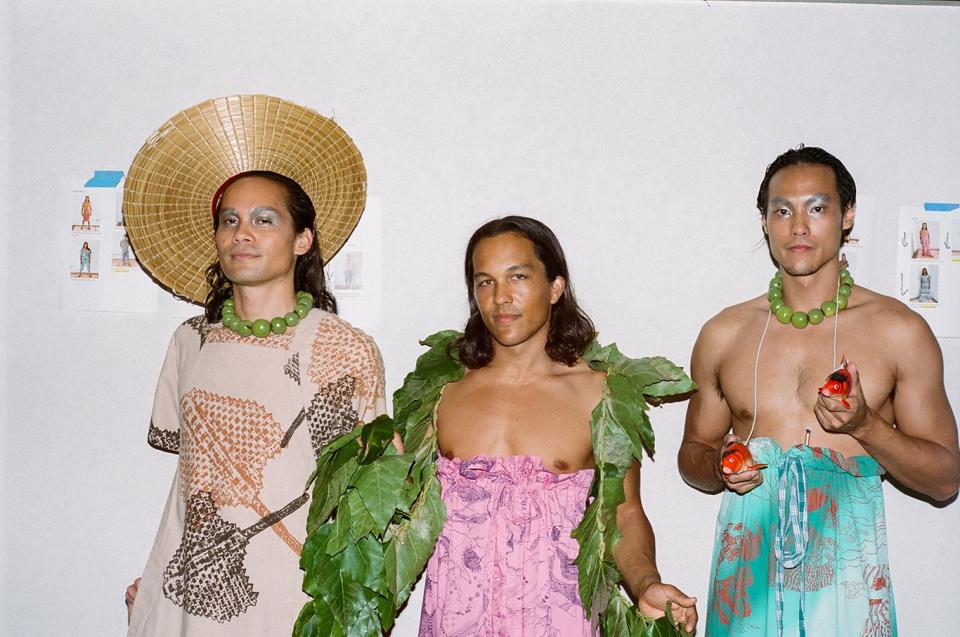
“He did drops before there were drops,” suggests Cervantes. Awai branched out to Honolulu’s top department stores in addition to craft fairs, but often kept his designs for either his annual fashion shows—which function more like theatrical musical affairs, with a theme and skits that feature Hawaii’s best musical talent, such as the Brothers Cazimero or hula dancers—or the Merrie Monarch Festival craft fair, an annual weeklong celebration and hula competition. Awai frequently designed custom orders for clients or costumes for hālaus (hula schools) and entertainers.
“He didn’t flood the market,” says Zane. Their rarity made Awai’s fashions all the more special, although now his label is more accessible. In 2021, Awai—who no longer designs because of health reasons—brought on his godson, Keane Akao, to oversee the business. Today the brand has an online shop and Instagram presence where anyone can tap to buy with one click.
This newfound availability doesn’t diminish the deep-rooted meaning behind the clothing, though. “Anyone that wears Nake‘u, it’s because of some sort of deeper connection,” says emerging designer Rocket Ahuna, who learned to sew with Nake‘u Awai scraps. “There’s so much depth, whether it’s what the print has to say, the style has to say, or what you feel connected to within your own family. Designers try to achieve one of those things—and he’s able to do all three impeccably.”
Estes agrees his clothing touches something beyond aesthetics. “When the Hawaiian person puts [a Nake‘u shirt] on or a mu‘u, it’s like, ‘I’m proud to be Hawaiian,’” she says. “There’s a regalness in wearing a Nake‘u that everyone feels innately.”
It’s true that owning and wearing Nake‘u Awai feels radical and nostalgic, particularly right now. This could be the clothing itself—its playfully bold proclamations and inherent storytelling—or the fact that fashion is inextricable from the historic contexts in which it is created. Awai is synonymous with the Second Hawaiian Renaissance of the 1970s, when a resurgence of Hawaiian culture, from dance to language to voyaging and sovereignty, reigned in public spaces. Hawaii is undergoing another renaissance now: In 2014, fashion designer Shannon Hiramoto started Mu‘umu‘u Month, encouraging younger generations to wear mu‘u, once seen as outdated, every day in January. Leis, the ceremonial flower garlands, are being reinterpreted and worn outside of special occasions. Hawaii’s sovereignty, water rights, income disparity, and politics are in the national consciousness again, after the devastating Maui fires in August, the Navy’s Red Hill fuel leak in November 2021, and the Mauna Kea telescope protests that began in 2014.
Though always an inspiration for American and European designers, Hawaii has been overtly referenced in fashion recently. In 2021, REDValentino and Sea New York were criticized for stealing quilt patterns—REDValentino from Allen Akina, and Sea from Hannah Ku‘umililani Cummings Baker and Rebecca Mahoe Haalou Medeiros. Proenza Schouler was called out by fashion watchdog Diet Prada for the insensitive styling and exorbitant pricing of the lei hulu (a lei made of feathers, created by cultural practitioners on Maui) in its Spring/Summer ’22 collection. More collaboratively, Jacquemus staged its Spring 2022 “Le Splash” show on Oahu, tapping only local talent through kamaaina stylists Taylor Okata and Ben Perreira. Saturday’s Surf collaborated on Spring 2023 with Sig Zane. Loewe showcased Hawaiian quilts by the Poakalani quilting circle at Salone del Mobile in Milan in 2019. CR Fashion Book styled local models in Maison Valentino’s Spring/Summer 2023 collection this year. And just this month, Louis Vuitton under Pharrell Williams’s creative direction cited the Men’s Pre-Fall 2024 surf-inspired silhouettes “as an homage to the floral Hawaiian shirt.”

As these designers continue to turn to Hawaii—largely because of social media, says Zane—it feels important that Awai be etched into fashion history, his place firmly cemented for proper reference, since, as Rocket Ahuna puts it, “Nake‘u is the mood board, but people don’t realize it.”
When asked if he wishes he were better known, Awai shrugs. “I wasn’t interested in the extravagant life,” he says. The most he says of his legacy is this: “In one word, I was fearless.” By leaping into a second career without any second doubts, he says, he learned that “the result of being fearless is gratification.”
Awai is content. He has fulfilled his mission to design clothing for local people and put his label in the hands of a leader he trusts. As for his role now? The designer smiles puckishly, a glimpse of his theatrical side showing. “Wise man watching,” he says.
You Might Also Like

